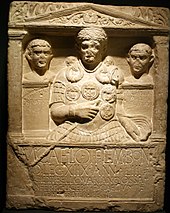Swagger stick
A swagger stick (lat: vitis) is a short stick or riding crop usually carried by a uniformed person as a symbol of authority. A swagger stick is shorter than a staff or cane, and is usually made from rattan.
Vitis

In the Roman army the swagger stick, then called a vitis, was a distinction of rank worn by a centurion and used to direct military drill and manoeuvres, or to administer physical punishment. It was a short vine wood staff, hence the name, about the size of a cane and is often prominently featured on sepulchral monuments for dead or missing centurios as a sign of their dignity.
Tacitus recounts how one centurio earned the nickname Cedo Alteram ("give me another!") for repeatedly breaking his vitis on the back of a miles gregarius and yelling for a replacement[1]. This policy resulted in mutiny (14 CE) and the troops cite, amongst other complaints, harsh corporal punishments as a reason for their revolt[2].
United Kingdom armed forces
Swagger sticks are most familiarly carried by military officers[citation needed] or more senior non-commissioned officers[citation needed]. They are also often carried by officers in police and paramilitary forces[citation needed] .
In the British Army and other militaries following the Commonwealth traditions, some commissioned officers used to carry swagger sticks when in uniform, whilst some Warrant Officers and Senior NCOs may carry pace sticks instead. Cavalry officers will often carry a riding crop rather than a swagger stick, in deference to their mounted traditions. Tradition in the Royal Tank Regiment is for officers to carry an 'ash plant' or walking stick instead, in reference to World War I tank attacks, when officers would prepare lines of advance by testing the ground's firmness and suitability for tanks.[3]
United States armed forces
Swagger sticks were once in vogue in the United States Marine Corps, starting as an informal accessory carried by officers in the late 19th century. In 1915, it gained official approval as recruiters were encouraged to carry them to improve public image. This tradition grew when Marines deployed for World War I encountered European officers carrying swagger sticks, leading to an entry in the uniform regulations in 1922 authorizing enlisted Marines to carry them as well. The usage died down in the 1930s and 40s, excepting China Marines, and returned in vogue when a 1952 regulation encouraging them; reaching a peak from 1956 to 1960, when Commandant Randolph M. Pate encouraged use. While stressing the need for uniforms to be simple and rugged, with no need for gimmicks and gadgets, General Pate commented:
There is one item of equipment about which I have a definite opinion. It is the swagger stick. It shall remain an optional item of interference. If you feel the need of it, carry it…
However, his successor, David M. Shoup, quickly discouraged their use:
..."the swagger stick symbolized elitist affectation, and it reminded him of some unpleasant experiences he had had in China.” He had seen British officers toss money at Chinese men and then strike them with their swagger sticks as they picked up the coins off the ground. Few Marines carried the swagger stick after that.[4]
Few, if any, contemporary officers feel the need to carry a swagger stick, and it has no official sanction in any branch.
General George S. Patton carried a swagger stick throughout World War II; however his contained a concealed blade, similar to a Victorian gentleman's sword cane.[5]
General William J. Livsey, who was the Commanding General of the Eighth United States Army in South Korea from 1984 to 1987 publicly carried a swagger stick that was carved from wood collected at the Korean Demilitarized Zone Axe Murder Incident poplar tree.
See also
http://www.tecom.usmc.mil/HD/Docs_Speeches/Swaggerstick.htm
References
- ^ Tacitus, Annales I 23.
- ^ ibid
- ^ Fletcher, David (1984). Landships: British Tanks in the First World War. HMSO. p. 25. ISBN 0-11-290409-2.
- ^ Borsh, Fred L. (16 March 2009). "Swagger stick reached its zenith in the 1950s". Marine Corps Times. Gannett Company. pp. p38. Retrieved 10 March 2009.
{{cite news}}:|pages=has extra text (help); Unknown parameter|coauthors=ignored (|author=suggested) (help) - ^ See under the GENERAL GEORGE S. PATTON, JR. section
External links
